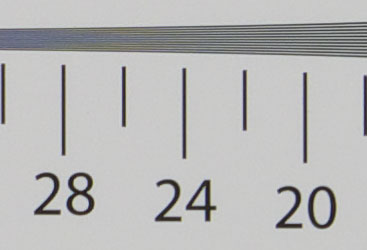Panasonic Lumix DMC-GH1
-
-
Written by Gordon Laing
Studio resolution: Panasonic Lumix DMC-GH1
Horizontal resolution using in-camera JPEGs
Panasonic Lumix DMC-GH1 with G VARIO 14-140mm |
Canon EOS 500D / T1i with EF-S 18-55mm IS | |
 |  | |
2250 lpph, 14-140mm at 25mm, f8, 100 ISO |
2400 lpph, 18-55mm at 35mm, f8, 100 ISO | |
Nikon D5000 with Nikkor DX 18-55mm VR |
Olympus E-620 with Zuiko Digital 14-42mm | |
 |  | |
2250 lpph, 18-55mm at 35mm, f8, 200 ISO |
2350 lpph, 14-42mm at 25mm at f8, 100 ISO |
Vertical resolution using in-camera JPEGs
Panasonic Lumix DMC-GH1 with G VARIO 14-140mm |
Canon EOS 500D / T1i with EF-S 18-55mm IS | |
 |  | |
2250 lpph, 14-140mm at 25mm, f8, 100 ISO |
2400 lpph, 18-55mm at 35mm, f8, 100 ISO | |
Nikon D5000 with Nikkor DX 18-55mm VR |
Olympus E-620 with Zuiko Digital 14-42mm | |
 |  | |
2250 lpph, 18-55mm at 35mm, f8, 200 ISO |
2350 lpph, 14-42mm at 25mm at f8, 100 ISO |
Panasonic Lumix DMC-GH1 Studio resolution: JPEG versus RAWWe photographed our test chart in the GH1’s RAW plus Large Fine JPEG mode, allowing us to directly compare images created from exactly the same data. Below are crops taken from the original JPEG file alongside the RAW version, processed in the supplied SilkyPIX Developer Studio 3.0 SE; by default, the Unsharp Mask is set to zero in SilkyPIX, which unsurprisingly delivers a very soft result, so here we’ve increased the amount to 100 in order to reveal fine details. The RAW versions, with their boost in sharpening, cut through the fuzziness on the JPEGs to deliver a measurably higher result of 2400 lpph. So even when equipped with the 14-140mm kit lens, you can still achieve resolving power similar to the earlier G1 with its 14-45mm lens. Shooting in RAW and boosting the sharpening has certainly delivered a preferable result here, but don’t assume it’s suitable for all images – on the previous page, the same treatment revealed a slightly unnatural-looking posterised effect on very fine real-life details. That said though, careful processing of RAW files should still deliver a preferable result over the in-camera JPEGs. Now let’s check out the camera’s performance at different sensitivities in our Panasonic GH1 High ISO noise results page. |
Panasonic Lumix DMC-GH1 JPEG with G VARIO 14-140mm |
Panasonic Lumix DMC-GH1 RAW (with sharpening) with G VARIO 14-140mm | |
 |  | |
2250 lpph, 14-140mm at 25mm, f8, 100 ISO |
2400 lpph, 14-140mm at 25mm, f8, 100 ISO | |
Panasonic Lumix DMC-GH1 JPEG with G VARIO 14-140mm |
Panasonic Lumix DMC-GH1 RAW (with sharpening) with G VARIO 14-140mm | |
 |  | |
2250 lpph, 14-140mm at 25mm, f8, 100 ISO |
2400 lpph, 14-140mm at 25mm, f8, 100 ISO |
Panasonic Lumix DMC-GH1 results continued…
|
In terms of resolving power, the Panasonic Lumix DMC-GH1 delivers 2250 lpph of horizontal and vertical resolution when equipped with the G VARIO 14-140mm kit lens. This score is identical to that measured by the Nikon D5000 with its DX 18-55mm VR kit lens, although falls below that measured from the Canon EOS 500D / Rebel T1i and Olympus E-620, again each using their kit lenses.
Perhaps more revealingly, the GH1 with the 14-140mm scored lower in this test than the earlier G1 with the 14-45mm kit lens. We know the GH1’s sensor is different to its video-less counterpart, but it does share the same pixel density and resolution when using the 4:3 aspect ratio tested here. We believe the G1’s higher score of 2450 lpph for both horizontal and vertical resolution is simply down to the difference in their kit optics: the G VARIO 14-45mm kit lens appears to be sharper than the G VARIO 14-140mm. Sadly we were unable to test the GH1 with the same 14-45mm lens to confirm, but hope to present results from other lenses in the future.
This shouldn’t be too much of a surprise though, as super-zooms rarely match the quality of lenses with shorter ranges: what you gain in convenience, you lose in ultimate quality.
But some of the GH1’s softness is down to image processing, as you’ll see in our RAW results at the bottom of the page. Alternatively, head straight on over to our High ISO Noise results page to see how it compares across its sensitivity range.





